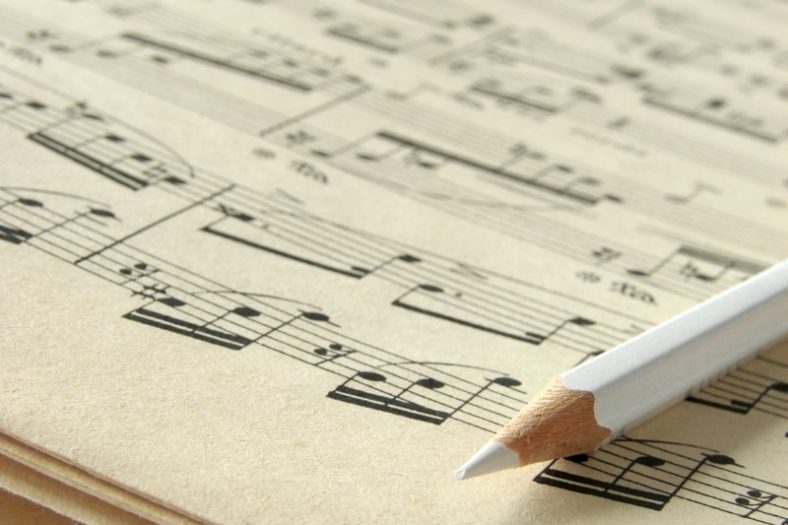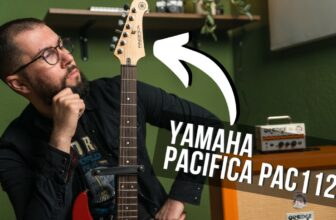Ghost Notes on Guitar – What are They and How to Play Them?

A ghost note is a note that has no specific pitch and therefore can’t be recognized as high or low. A ghost note is usually indicated on sheet music by an X, meaning that the note should be muted.
One of the most searched and overlooked topics among most guitarists is the ghost notes technique. Ghost notes are the little percussive in-between sounds created either with muted single-notes or chords.
A ghost note or a dead note is a term derived from drums and percussion, as ghost notes are a key technique for these instruments. It is also called an anti-accent or negative accent note as they are light and faint notes in-between the accented hits.
Contents
How to Play Ghost Notes on Guitar?
There are several ways to play ghost notes on a guitar. You can deploy this technique to your single-note playing as well as chord strumming.
First, let’s go with the single-note technique. One way to use ghost notes while playing a single-note melody is to mute the strings with the fretting hand in-between specific notes. You can lift the pressure without taking your fretting finger off the string. Keep lightly touching the string to mute it and pick it up to create a percussive sound which is a ghost note.
You can use the same technique while strumming chords, too. While strumming chords, flatten your fingers and decrease the pressure on the frets, lightly touching all strings. When you keep on strumming, you will get the funky muted percussive sounds, which are ghost notes. Using them in-between chords will give you a nice percussive sound to embellish the piece you are playing.
Another way is to use the slap technique to create ghost notes. You can slap the strings with your picking hand to create a percussive sound. Your thumb will do most of the job here, slapping the lower strings and creating those percussive ghost notes.
Ghost notes are indicated with an X sign on musical sheets and guitar tabs. When you see an X sign instead of a number on guitar tabs or a circle in musical sheets, that means you have to play a dead note or, with its other name, a ghost note there.
Exercises for Playing Ghost Notes
There are a few ways to practice ghost notes spanning from beginner to more advanced. First, you can try single notes and slowly progress to chords and scales.
If you are a beginner guitarist, pick any note and play it normally 2 times and as a ghost note for 2 times with a slow tempo. Later you can experiment with different notes as you play ghost notes and normal notes in various amounts following each other.
Later, you can exercise playing ghost notes on your regular scale exercises. Try to use a couple of ghost notes on your scale runs, muting the strings here and there. A good way to practice is to add ghost notes to a specific beat like the 3rd one. Try to play a ghost note on every 3rd beat on your scale run.
Another fun exercise is to use the ghost notes on the riffs, melodies, and solos you have already learned and mastered. Depending on the rhythm of the piece you are playing, add some ghost notes here and there, embellishing the piece with funky percussive dead notes.
You can also use ghost notes while strumming chords of the pieces you know, making them sound more percussive. Or, you can learn some funky tunes as they are full of percussive playing and ghost notes.
Some solos use a technique called rakes, which adds one or more ghost notes right before the actual note is being played. So, you build your way up to a particular note with ghost notes. Choose a note on the high E string and try adding a ghost note on a B string before playing the one on the E string.
Later you can add more ghost notes on other strings to have more of those percussive “click” sounds before the normal note. Rakes especially sound nice before a good old bend on high strings.
Rakes are found in many songs, such as in the solo of Pink Floyd’s Another Brick In The Wall Part 2. You can also take a look at these solos, as they are great exercises to practice ghost notes and rakes.
Are Ghost Notes Only on Guitar?
Not at all. As ghost notes are percussive notes without a clear pitch, the technique is actually derived from percussion instruments and drums.
Ghost notes on percussion are softly played notes without accent in-between accented hits.
However, the technique is used in almost every instrument. Mainly stringed instruments, especially basses, use ghost notes frequently, but wind instrument players also gave advanced techniques to incorporate ghost notes in their playing.
Ghost notes can be found in vocal music too which we will discuss in the following sections.
Are There Any Songs That Use Ghost Notes?
There are many famous songs, which use ghost notes in their riffs, chord progressions, or solos.
As the name suggests, they are ghost notes, which are hard to recognize without a careful ear. But, if you listen to them after this article, you will notice them quickly.
One of the first songs to come to mind with ghost notes in their chord progression is the famous Smells Like Teen Spirit by Nirvana. The main riff has sixteenth-note ghost notes between the power chords, which you can hear right at the song’s beginning.
Mark Knopfler of Dire Straits is one of the guitarists who frequently uses ghost notes in his fingerpicking style of playing. In the main riff of Money For Nothing and the licks and solos of Sultans Of Swing, you can catch many ghost notes embellishing the guitar partitions.
David Gilmour likes to use rakes very often when playing his solos. In Another Brick In The Wall Part 2’s solo, he uses many rakes, including a lovely triplet one right before the iconic bend in the high E string.
Funk-style guitar playing is all about ghost notes and percussive playing. You can find ghost notes in any funk song. One of the most famous examples is Jungle Boogie by The Kool And The Gang. Listen to the guitar in the background. It plays more ghost notes than actual notes.
What is a Ghost Note in Vocal Music?
Ghost note in vocal music has the same goal as it is with the other instruments: A ghost note phrase is a phrase with rhythmic features but no pitch.
To utilize a ghost note in singing, a phrase is spoken rhythmically instead of sung.
Ghost notes are often used in musicals but extremely rarely in songs. You can check the Rock Island, the opening of The Music Man musical, to listen to ghost notes being used in vocal music.
Summary
In short, ghost notes are musical notes without pitch but a rhythmic feature. They embellish the pieces by adding percussive features to the musical phrases and are shown with an X sign on the musical sheets.
In drumming, ghost notes are played by lightly touching the instrument creating a contrast with accented notes, and in stringed instruments, they are played by muting the strings, creating a percussive sound out of them. You can use ghost notes to embellish your guitar playing and sound more professional.





